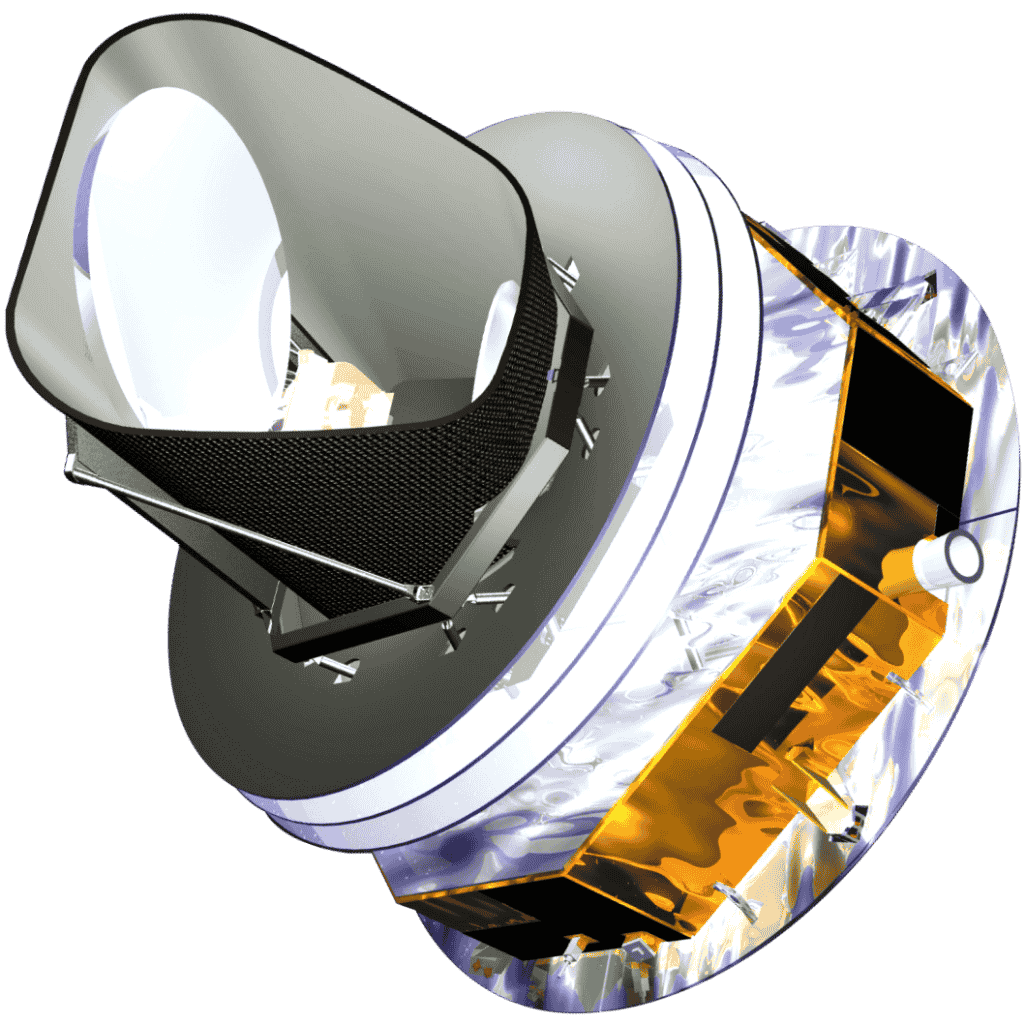Planck Observatory
Cosmic Background Explorer
Microwave telescope studying the early universe

USPs
- Maps Cosmic Microwave Background with high precision
- Located at L2 for stable observations
- Refines cosmological parameters like universe’s age
- Coldest operational temperature (0.1 K) for sensitive measurements
- Dual instruments: High Frequency Instrument (HFI) and Low Frequency Instrument (LFI)
- Provided polarization data for deeper insights into cosmic structure
- Helped confirm the standard model of cosmology
Major Milestones
- 2009-05-14: Launched aboard an Ariane 5 rocket from Kourou, French Guiana, alongside Herschel, marking the start of its mission to study the cosmic microwave background.
- 2009-07-03: Reached the L2 Lagrangian point and entered a Lissajous orbit, achieving the coldest operational temperature of 0.1 K for its instruments.
- 2009-08-13: Began its first all-sky survey, initiating detailed mapping of the cosmic microwave background with high sensitivity and resolution.
- 2010-02: Completed its first all-sky survey and started a second survey, exceeding initial expectations for data collection.
- 2011-01: Released the Early Release Compact Source Catalogue (ERCSC), providing the astronomical community with initial data on foreground sources.
- 2012-01-13: Exhausted its helium-3 coolant, rendering the High Frequency Instrument (HFI) unusable, though the Low Frequency Instrument (LFI) continued operations.
- 2013-03-21: Released the first all-sky map of the cosmic microwave background, offering unprecedented detail on the early universe's temperature variations.
- 2015-02: Published an expanded data release including polarization data, enhancing understanding of the universe's structure and evolution.
- 2018-07: Released final papers and data, concluding the mission with the most precise measurements of the universe's age, geometry, and composition.
- 2025-07-17: Data continues to be analyzed, influencing ongoing cosmological research despite the observatory's decommissioning in 2013.
Cosmic Portrait
Planck Observatory: Mapping the Early Universe
Planck Observatory, launched by the European Space Agency (ESA) in 2009, was one of the most ambitious missions ever designed to study the Cosmic Microwave Background (CMB)—the faint afterglow of the Big Bang. This radiation, which fills the universe, holds vital clues about its infancy, composition, and large-scale structure.
- Scientific Purpose: Planck’s main goal was to capture the most detailed map ever made of the CMB, measuring tiny temperature and polarization variations across the sky. These subtle fluctuations reveal information about the universe's age, shape, contents, and even its earliest moments of inflation.
- Location and Environment: Positioned at the Lagrange Point L2, about 1.5 million kilometers from Earth, Planck enjoyed a stable, cold environment, free from Earth's thermal interference. This allowed it to perform ultra-sensitive measurements of the microwave sky without noise or distortion from nearby heat sources.
- Technological Precision: Planck operated across nine frequency bands, ranging from 30 GHz to 857 GHz, using cryogenically cooled detectors to achieve unmatched precision. This multi-frequency capability was essential for separating the CMB from other foreground emissions like dust and galactic radio waves.
A Legacy of Cosmological Discovery
Although the mission ended in 2013, Planck’s legacy endures strongly in 2025. Its final data release reshaped modern cosmology by narrowing down the values of fundamental parameters like the Hubble constant, the density of dark matter and dark energy, and the overall curvature of the universe.
Planck also confirmed key predictions of the Big Bang theory and gave the most compelling evidence yet for cosmic inflation—a rapid expansion that occurred fractions of a second after the universe's birth. In doing so, it built upon and vastly improved the earlier results from NASA’s WMAP mission, setting a new gold standard for cosmological observations.
Impact on Physics and Astronomy
Beyond its direct scientific findings, Planck’s influence extends into fields like particle physics, dark energy research, and the study of large-scale cosmic structure. Its data continues to power theoretical models and simulations, and researchers worldwide are still mining its datasets in search of new cosmological insights and anomalies.
Thanks to Planck, we now have a clearer picture of when the first atoms formed, how galaxies clustered, and how the cosmic web evolved. It confirmed that dark matter makes up about 26% of the universe, while dark energy—the mysterious force driving cosmic acceleration—accounts for roughly 69%. Ordinary matter, the stuff we can see, is just a small sliver of the cosmic pie.
Planck looks back to the Big Bang, unveiling the universe’s oldest light.
In the grand quest to understand our origins, Planck serves as a time machine, showing us what the cosmos looked like just 380,000 years after the Big Bang. It remains a towering achievement in humanity’s exploration of the ultimate question: Where did it all begin?
Fun Fact
Planck’s data helped confirm the universe is 13.8 billion years old!